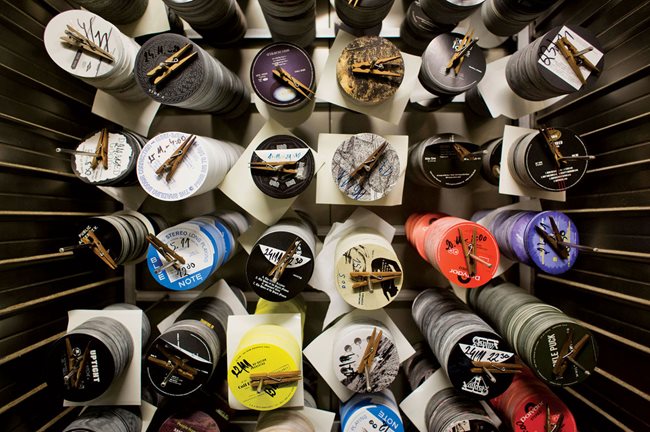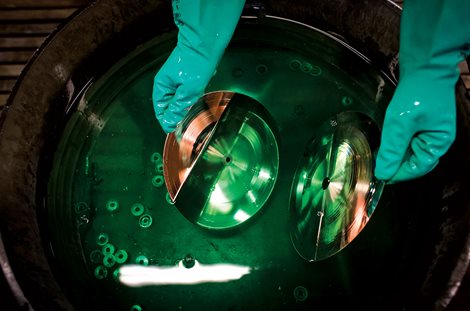02/2015
Bloomberg
A company that hung on to its record-stamping machines is now the world’s No. 1 maker of LPs
 Photographer: Martin Divisek/Bloomberg
Photographer: Martin Divisek/Bloomberg
Hipsters in London, New York, and Seattle may be the driving force behind the resurgence of vinyl records. Yet few outside the music industry know that the return of the LP is truly a Bohemian story. Lodenice, a village 16 miles outside Prague, is home to the world’s biggest producer of vinyl.
Albums by Black Sabbath, David Bowie, and U2 line the walls at the headquarters of GZ Media, which last year pressed 13.7 million records for up-and-coming indie labels along with industry stalwarts such as Sony and Universal Music Group. The Czech company is riding the wave of the LP revival, thanks to a fleet of half-century-old presses still capable of producing top-quality discs. “It was our great stroke of luck that even in the meager 1980s and 1990s, when nobody was buying vinyl anymore, the management decided to keep the machines and never threw them out,” says Michal Nemec, GZ’s sales and marketing director. In the U.S., 80 percent of record-making equipment was scrapped, says Bob Roczynski, owner and president of Record Products of America, a Hamden (Conn.) company that supplies machine parts to the dozen or so surviving plants in the U.S. Order backlogs at many of those companies now run three to four months, he says. “In the old days, if you were backlogged that much, you weren’t doing something right.”
 Separating the copper master disc, left, from the nickel “stamper” that’s used in manufacturing.
Separating the copper master disc, left, from the nickel “stamper” that’s used in manufacturing.
Photographer: Martin Divisek/Bloomberg
Sales of vinyl LPs hit 9.2 million in the U.S. in 2014, a 52 percent increase from the previous year, according to Nielsen Music. Nielsen’s numbers, which go back only to the early 1990s, show sales hitting a low of 300,000 in 1993. In the U.K., record sales topped a million last year, a milestone not reached since 1996, says Official Charts Co. “There’s a kind of back-to-basics movement now, especially in London. People knit their clothes, grow their own organic veggies. Buying vinyl records is just part of that,” says a sales clerk at the Rough Trade record store in Nottingham who goes by his DJ name, Nail.
Originally named Gramofonove Zavody Lodenice, GZ pressed its first record in 1951. By the 1960s the state-owned enterprise was making LPs for much of the Soviet bloc, until cassettes and later compact discs pushed the brittle black discs to the brink of extinction. GZ embraced the new audio technologies—CDs are one of its mainstays—but didn’t stop making records entirely, though it did mothball some equipment. Winslow Partners, a U.S. private equity fund, acquired GZ in 1998 and sold it to the company’s management a few years later.
Records contributed just one-third of GZ’s 2014 revenue of 2.1 billion koruna ($86.6 million). Besides CDs, the company diversified into paper printing in the 1990s and today produces packaging for Diageo, Ikea, and Samsung. Still, vinyl is its fastest-growing division: Sales grew 25 percent last year and are forecast to increase as much as 30 percent this year, says Nemec.
.aspx?width=300&height=423)
The company operates several record presses dating from the 1960s and just began to test a prototype it developed in-house. Customers send their recordings as digital files, though occasionally the company still receives CDs, says Zbynek Lebr, the head of the acoustics lab. A computer transmits the signal to a turntable outfitted with a diamond needle. The needle cuts the copper-plated master disc in real time, which means Leber usually has to listen to the entire album while checking the freshly cut disc through a microscope. The job has broadened his musical horizons, he says: “It enriches you.”
To make its records, GZ employs a widely used technique called direct metal mastering. A master disc is submerged in a “galvanic bath” for about an hour until it’s covered with a layer of nickel. The layer is peeled off and used to stamp the vinyl biscuits under high pressure to create the black discs. Each nickel “stamper” can be used to press up to 500 records.
The factory puts out about 100 different albums on an average day, each with a minimum run of 500 LPs. “All major bands now demand to issue their albums on vinyl,” says GZ’s sales and marketing manager, Jana Brezinova. “It’s become a marketing necessity,” she says, pointing to a wall filled with singles.
.aspx?width=460&height=306) A worker at GZ Media packages a pressed 12-inch LP. Photographer: Martin Divisek/Bloomberg
A worker at GZ Media packages a pressed 12-inch LP. Photographer: Martin Divisek/Bloomberg
GZ opened another factory an hour and a half from Prague last fall so it could devote more of the Lodenice operation to making LPs. Nemec says he doesn’t expect the vinyl craze to peter out soon. “Nobody can really predict what’s going to happen in three or four years, but I think this renewed interest in vinyl is more than just a short-lived fad,” he says.
The bottom line: GZ Media is riding resurgent interest in vinyl records, sales of which were up more than 50 percent in the U.S. last year.